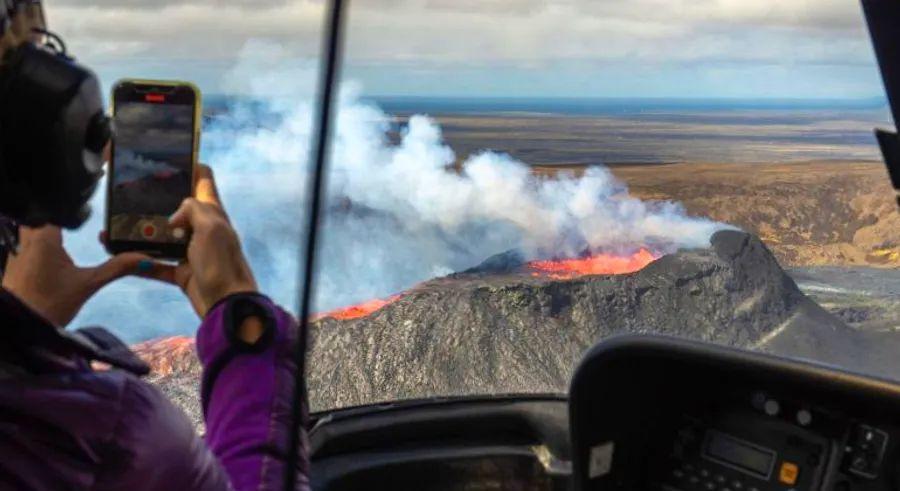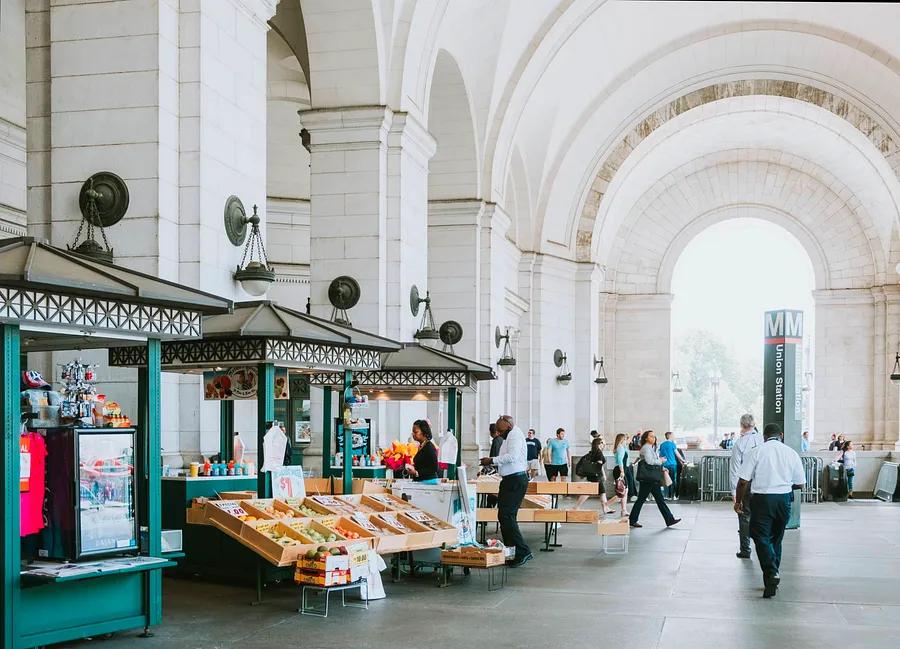Currently in Iceland: A Fiery Lava Spectacle and a Warm Reception

A mere 25-minute drive from Keflavik International Airport, a dynamic hiking path stretches over two miles, leading to a breathtaking view of what might just be the most captivating natural display on Earth at the moment.
Iceland's newest volcano, Geldingadalur, erupts in a fiery fountain of vivid orange lava that spills over the caldera’s rim with such intensity that visitors can sometimes feel its warmth on their skin.
Long after witnessing the eruption on the Reykjanes Peninsula, located about 35 miles (56 kilometers) south of Reykjavik, I couldn’t shake the memory of the spectacular event.
While traveling with my sister and a friend last week in the southwest region, we'd often find ourselves in some of Iceland's most beautiful spots – yet we couldn’t help but stay glued to the live volcano stream on our phones, checking it as if it were a baby with restless sleep.
Being in Iceland right now – open to fully vaccinated travelers (including from the UK and US) and those with proof of recovery from a past Covid-19 infection since April 6 – offers the usual Icelandic blend of awe-inspiring landscapes and the comforting sense of returning to some kind of normalcy.
The government recently removed mask mandates in most indoor spaces, except for airports and public transport. During my weeklong stay in early June, I only wore a mask twice.
The first time I wore a mask was upon entering the airport, where I underwent the required Covid-19 nasal and mouth test (a rule that will be lifted July 1 for vaccinated travelers and those with proof of prior infection). The second was during a brief ferry ride.
“You could really feel the collective relief in town when the mask rules were relaxed,” said Erling Jóhannesson, a goldsmith in Reykjavik and the chairperson of The Federation of Icelandic Artists. “It’s like we’re finally moving past this difficult time.”

All the iconic sights, without the usual crowds
With easy access and a smooth arrival process for vaccinated travelers and those who have proof of recovery (after a free Covid-19 test on arrival, travelers simply wait for results, typically received via text within six hours), what draws visitors to Iceland remains the same.
In Iceland, where glaciers crawl over volcanoes and fulmars glide above sea cliffs, every twist in the road brings you face to face with awe-inspiring natural wonders.
The erupting volcano, which began on March 19, is the perfect finishing touch, offering a primal display while reminding us that change is the only constant in life.
There's a subtle shift in the air in Iceland right now – a quiet sense of gratitude and hope. It feels more like a mutual exchange between locals and visitors than it has in recent years.
In the lobby of Hotel Rangá in Hella, Maura Creekmore from Fair Haven, New Jersey, shared that she’d come for a week-long vacation with her husband, daughter, and 84-year-old mother.
“The moment we got vaccinated, I was Googling ‘Where will they accept Americans?’ trying to find a place to visit,” said Creekmore, who had visited Iceland in the winter of 2019 and had been yearning to return ever since.

“Iceland was the first place to open up, so I thought, ‘We’re going,’ ” she said.
The common response I heard from many American travelers about why they chose Iceland – and why now – was simply a spin of the globe and hoping for the best. (Almost all of the travelers I met were from the U.S.)
At the Blue Lagoon, a group of Vanderbilt University graduates were celebrating with a relaxing soak before setting off on a road trip around Iceland’s famous Ring Road. Meanwhile, a family from Florida, on their second visit, joined a tour to see puffins on the Westman Islands.
“Last time I visited, I actually stumbled over someone at the black sand beach – it was that packed,” said Janet Krawczyk from Lake Magdalene, Florida, who was traveling with her husband, son, and his girlfriend. This time, they were delighted to find places like Reynisfjara, on the south coast, completely crowd-free.
“In 2019, we had to wait our turn to take a photo at the railing at Gullfoss,” she said, referring to one of Iceland's most iconic waterfalls along the Golden Circle route.

A hopeful perspective
During conversations with locals throughout the week, it was evident that most Icelanders were eager for visitors to return, although many had enjoyed the quieter pace of life in their own country over the past year.
Tourism in Iceland has experienced an extraordinary boom over the past decade, to say the least.
Following the 2010 eruption of Eyjafjallajökull, which wreaked havoc on European air travel, Iceland found itself thrust into the global spotlight – and the tourism industry's crosshairs as well.
With a population of about 360,000, Iceland saw its foreign visitor count soar from roughly half a million in 2010 to over two million by 2019, according to the Icelandic Tourist Board.
“It felt like a gold rush,” recalled Sveinn Snorri Sighvatsson, an adventure guide with Troll Expeditions, remembering a particularly chaotic moment in 2016 when he was leading visitors on one of the country’s most scenic multiday hikes, forcing him to push through the crowds.
“We started finding trash outside the cities, scattered across the wild nature,” he said. “People were tossing cigarette butts and garbage in the Highlands, then complaining, ‘Why don’t you have trash cans here?’”

When Sighvatsson started hearing the familiar sound of tourists dragging their luggage through the streets of Reykjavik in recent weeks, he felt a sense of relief. But he hopes that as tourism resumes, it will come with greater respect for the island’s delicate environment.
“If you ask tourists, they don’t feel we were overwhelmed by visitors,” said Friðrik Pálsson, owner of Hotel Rangá. “But if you ask locals, we’re a small population, and we’re not accustomed to so many people in our space.”
During the pandemic, Pálsson noted, business at his 52-room hotel, located by one of Iceland’s most renowned salmon rivers, plummeted by almost 90%. It began to pick up again in early May, he said, thanks to increased flights from Icelandair and Delta Air Lines.
Since then, booking requests have been “like a volcanic eruption in the hotel’s inbox,” Pálsson said, with stays now averaging nearly two days longer than previous years.
“As things stand, we’re expecting a very busy July and August,” he said. “I don’t see any reason to feel pessimistic.”

A warm return
There was a palpable sense of optimism during my visit, even though when my friends and I stopped at Gullfoss, our rental Land Cruiser was the only car in the parking lot.
We had the roaring falls all to ourselves for 15 minutes, until a couple appeared over the hill.
When I asked at the gift shop where everyone was, the cashier replied, “It’s still early in the day” (it was 11 a.m.).
“It’s been nice having the country all to ourselves for a while,” said Katrín Sigurðardóttir, owner of the Icelandic horse breeding farm Icelandic HorseWorld. She expressed happiness at seeing an increase in bookings for summer riding tours.
“I’ve enjoyed revisiting places I hadn’t been to in a while, like Gullfoss and Geysir,” she said about traveling within her own country during the pandemic. “And now I’m ready to go back to my favorite spots.”
In the cold plunge pool at Sky Lagoon, Reykjavik local Inga Bjork shared that she had enjoyed the lower hotel prices offered to Icelanders during the pandemic, but added she was “very happy” to see me.
“But why doesn’t the U.S. let us in, too?” she asked. “We’re getting vaccinated as well.”

She then showed me the trick to staying submerged longer in the freezing water (keep your hands above the surface) before directing me to the fjord-side sauna to warm up.
During the week I spent traveling mostly with Americans and Icelanders – hiking to ice caves and navigating an ATV across rivers in Þórsmörk Valley, where Hollywood had already resumed filming – I felt the warmth of the Icelandic welcome everywhere I went.
After dinner one evening at Hotel Rangá, an Icelandic guest expressed how thrilled he was to overhear tourists sharing stories of their adventures, saying he felt compelled to reach out and touch me. On a tour with Southcoast Adventure, guide Geirmundur Klein shared how pleased he was to see Americans returning to Iceland so soon.
“They come here to relax and enjoy themselves, and they’re naturally curious,” he said. “They’re easy-going and a lot of fun.”
The largest crowd I encountered all week was aboard the ferry to the Westman Islands, an archipelago home to the world’s biggest puffin colony, which was hosting a youth soccer tournament for Icelandic girls.

“We love tourists here,” he said.
We flew low over Geldingadalur as the pilot hovered, giving us a bird’s-eye view of the bubbling caldera before landing on a ledge above a steaming lava flow, which was slowly creeping toward the trail I had hiked just days earlier.
Egill Vignisson, who runs a digital agency in Keflavik, told me his brother was supposed to be on the flight but gave up his seat because his hotel, Lilja Guesthouse, had just reopened and was filled with guests.
We watched the volcano in action.

“Every eruption here is unique, but the fact that this one is occurring in our lifetime makes it even more remarkable,” he said about the first eruption on the Reykjanes Peninsula in over 800 years.
“It’s surreal to watch the landscape transform constantly, with each eruption erasing your previous footprints,” he said.
I asked him how he felt about the eruption, knowing it would likely boost tourism to the island even further.
“We generally love having tourists here, as it brings cultural diversity,” he said.
“It’s been a bit isolating without tourists, and with travel abroad also off-limits,” Vignisson said. “But we’ve come to appreciate our own country much more. Icelanders love sharing their homeland with others.”

1

2

3

4

5
Evaluation :
5/5